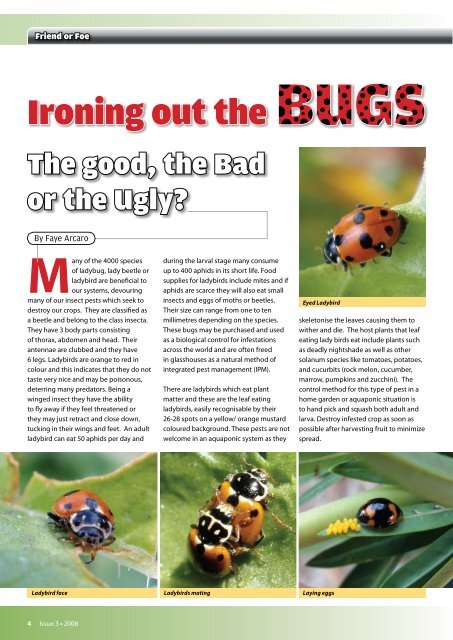Keeping Trout - Backyard Magazines
Keeping Trout - Backyard Magazines
Keeping Trout - Backyard Magazines
You also want an ePaper? Increase the reach of your titles
YUMPU automatically turns print PDFs into web optimized ePapers that Google loves.
Friend or Foe<br />
Ironing out the<br />
The good, the Bad<br />
or the Ugly?<br />
By Faye Arcaro<br />
Many of the 4000 species<br />
of ladybug, lady beetle or<br />
ladybird are beneficial to<br />
our systems, devouring<br />
many of our insect pests which seek to<br />
destroy our crops. They are classified as<br />
a beetle and belong to the class insecta.<br />
They have 3 body parts consisting<br />
of thorax, abdomen and head. Their<br />
antennae are clubbed and they have<br />
6 legs. Ladybirds are orange to red in<br />
colour and this indicates that they do not<br />
taste very nice and may be poisonous,<br />
deterring many predators. Being a<br />
winged insect they have the ability<br />
to fly away if they feel threatened or<br />
they may just retract and close down,<br />
tucking in their wings and feet. An adult<br />
ladybird can eat 50 aphids per day and<br />
4 Issue 3 • 2008<br />
during the larval stage many consume<br />
up to 400 aphids in its short life. Food<br />
supplies for ladybirds include mites and if<br />
aphids are scarce they will also eat small<br />
insects and eggs of moths or beetles.<br />
Their size can range from one to ten<br />
millimetres depending on the species.<br />
These bugs may be purchased and used<br />
as a biological control for infestations<br />
across the world and are often freed<br />
in glasshouses as a natural method of<br />
integrated pest management (IPM).<br />
There are ladybirds which eat plant<br />
matter and these are the leaf eating<br />
ladybirds, easily recognisable by their<br />
26-28 spots on a yellow/ orange mustard<br />
coloured background. These pests are not<br />
welcome in an aquaponic system as they<br />
Eyed Ladybird<br />
Ladybird face Ladybirds mating Laying eggs<br />
skeletonise the leaves causing them to<br />
wither and die. The host plants that leaf<br />
eating lady birds eat include plants such<br />
as deadly nightshade as well as other<br />
solanum species like tomatoes, potatoes,<br />
and cucurbits (rock melon, cucumber,<br />
marrow, pumpkins and zucchini). The<br />
control method for this type of pest in a<br />
home garden or aquaponic situation is<br />
to hand pick and squash both adult and<br />
larva. Destroy infested crop as soon as<br />
possible after harvesting fruit to minimize<br />
spread.


